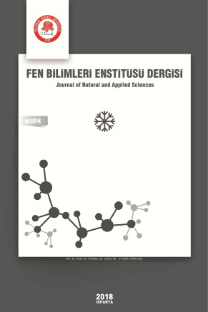A Comparisonof Confidence Interval Methods of Fixed Effectin Nested Error Regression Model
İç İçe Hata Regresyon Modelinde Sabit Etki Parametresi için Güven Aralığı Metodlarının Karşılaştırılması
___
- Demidenko, E. 2004. Mixed Models: Theory and Applications. Wiley, 726p.
- Eisenhart, C. 1947. The Assumptions Underlying the Analysis of Variance. Biometrics, 3(1), 1-21.
- Patterson, H.D., Thompson, R. 1971. Recovery of Inter-block Information When Block Sizes are Unequal. Biometrika, 58(3), 545-554.
- Searle, S.R., Casella, G., McCulloch, C.E., 2009. Variance Components (Vol. 391). John Wiley & Sons, 509p.
- Kackar, R. N., Harville, D. A. 1984. Approximations for Standard Errors of Estimators of Fixed and Random Effects in Mixed Linear Models. Journal of the American Statistical Association, 79(388), 853-862.
- Kenward, M. G. Roger, J. H. 1997. Small Sample Inference for Fixed Effects From Restricted Maximum Likelihood. Biometrics, 1997, 983- 997.
- Harville, D. A., Fenech, A. P. 1985. Confidence Intervals for a Variance Ratio, or for Heritability, in Model. Biometrics, 1985, 137-152. Mixed Linear
- Savin, A., 2005. Confidence Intervals for Common Mean in One-way Classification Model with Fixed Effects. Measurement, 2005, 15-19.
- Hall, P., Maiti, T. 2006. On Parametric Bootstrap Methods for Small Area Prediction. Journal of the Royal Statistical Society: Series B (Statistical Methodology), 68(2), 221-238.
- Staggs, V. 2009. Parametric Bootstrap Interval Approach to Inference for Fixed Effects in the Mixed Linear Model, PhD Thesis, University of Kansas, 73 p, Lawrence.
- Burch, B. D. 2011. Confidence Intervals for Variance Components in Unbalanced One-way Random Effects Model Using Non-normal Distributions. Journal of Statistical Planning and Inference, 141(12), 3793-3807.
- Liu, J. 2013. Statistical Inference for Functions of the Parameters of a Linear Mixed Model, PhD Thesis, Iowa State University, 75p, Ames.
- Neyman, J., Pearson, E. S. 1928. On the Use and Interpretation of Certain Test Criteria for Purposes I. Biometrika, 1928, 175-240. Inference: Part
- Wald, A. 1943. Tests of Statistical Hypotheses Concerning Several Parameters when the Number of Observations is Large. Transactions ofthe American Mathematical Society, 54(3), 426-482.
- Bates, D. M., Pinheiro, J. C. 1994. Model Building for Nonlinear Mixed Effects Models, University of Wisconsin, Department of Biostatistics.
- Lehmann, E. L. 1999. Elements of Large-Sample Theory. Springer Science & Business Media, 645p.
- Hulting, F. L., Harville, D. A. 1991. Some Bayesian and Non-Bayesian Procedures for the Analysis of Comparative Experiments and for Small-area Estimation: Computational Aspects, Frequentist Properties, and Relationships. Journal of the American Statistical Association, 86(415), 557- 568.
- Efron, B. 1992. Bootstrap Methods: Another Look at the Jackknife. Breakthroughs in Statistics. 1992, 569-593, New York.
- DiCiccio, T. J., Romano, J. P. 1988. A Review of Bootstrap Confidence Intervals. Journal of the Royal (Methodological), 338-354. Society. Series B
- DiCiccio, T. J., Romano, J. P. 1990. Nonparametric Confidence Limits by Resampling Methods and Least Favourable Families. International Statistical Review/Revue Internationale de Statistique, 1990, 59-76.
- Goldstein, H. 2011. Multilevel Statistical Models (Vol. 922). John Wiley & Sons, 358p.
- Zeger, S. L., Liang, K. Y. 1986. Longitudinal Data Analysis Outcomes. Biometrics, 1986, 121-130. and Continuous
- Chernick, M. R. 2011. Bootstrap Methods: A Guide for Practitioners and Researchers (Vol. 619). John Wiley & Sons, 369p.
- Efron, B., Efron, B. 1982. The Jackknife, the Bootstrap and Other Resampling Plans (Vol. 38). Philadelphia: Society for Industrial and Applied Mathematics, 92p.
- Efron, B., Tibshirani, R. J. 1994. An Introduction to the Bootstrap. CRC press, 436p.
- Halekoh, U., Hİjsgaard, S. 2014. A kenward- Roger Approximation and Parametric Bootstrap Methods for Tests in Linear Mixed Models-the R Package pbkrtest. Journal of Statistical Software, 59(9), 1-30.
- Bates, D., Maechler, M., Bolker, B., Walker, S. 2014. lme4: Linear Mixed-Effects Models Using Eigen and S4. R Package Version, 1(7).
- ISSN: 1300-7688
- Yayın Aralığı: 3
- Başlangıç: 1995
- Yayıncı: Süleyman Demirel Üniversitesi
<i>Tuta absoluta</i> ve <i>Macrosiphium euphorbiae</i>’nin Domates Bitkisinde Dikey Dağılımı
Alime BAYINDIR, Ali Kemal BİRGÜCÜ, İsmail KARACA
Kültürel Peyzaj Değeri Açısından Yörük Kültürünün İrdelenmesi
Şakire Dilşad ÖZÜBERK, AYŞE DELİGÖZ
SERKAN GÜLSOY, ÖZDEMİR ŞENTÜRK, Fatih KARAKAYA
Adana ve Konya İllerindeki Arıcılık Faliyetleri ve Koloni Kayıpları
A Comparisonof Confidence Interval Methods of Fixed Effectin Nested Error Regression Model
HATİCE TÜL KÜBRA AKDUR, DENİZ ÖZONUR, HÜLYA BAYRAK
Bazı Uçucu Yağların <i>Myzus persicae</i> ve Avcısı <i>Chrysoperla carnea</i> Üzerindeki Etkileri
Ali KAYAHAN, Betül ŞİMŞEK, Cansu KARACA, İsmail KARACA
